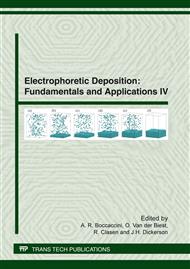p.175
p.181
p.191
p.197
p.203
p.209
p.215
p.221
p.227
Stability and EPD of Concentrated Suspensions of Alumina with Nanosized Titania
Abstract:
Alumina-aluminium titanate (A-AT) composites and laminates have been recently investigated because they can provide improved flaw tolerance and toughness associated to a microcracking mechanism. A-AT composites have been produced by slip casting and reaction sintering of submicron sized alumina and titania powders. This work deals with the preparation of thick self-sustained A-AT films from mixtures of submicron sized alumina and nanosized titania. Suspensions were prepared in water to high solids loadings ranging from 30 to 50 vol.%. The stability of diluted suspensions was studied through zeta potential measurements as a function of pH and deflocculant type and concentration. The stability of the concentrated suspensions as a function of deflocculant content, sonication time and solids loadings was studied from rheological measurements. Self-sustained films were obtained by aqueous EPD using graphite substrates under constant current density conditions. The evolution of mass per unit area with current density and deposition time was recorded. The films were characterized in the green state and after debinding and sintering by density measurements, and electron microscopy observations.
Info:
Periodical:
Pages:
203-207
Citation:
Online since:
March 2012
Authors:
Keywords:
Price:
Сopyright:
© 2012 Trans Tech Publications Ltd. All Rights Reserved
Share:
Citation:


